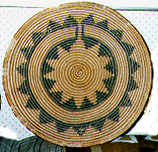

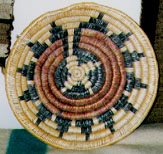
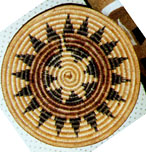
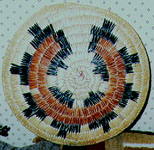
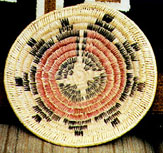
*Dine' means "the People" in the Navajo language (Dine'
bizhaad).
"These four baskets have the traditional Navajo basket design with the red, white, and black colors. The black design symbolizes the darkness (night) and clouds that bring the rain. The white part inside the black design represents the sacred mountains. Usually, there are four or six points in this part to designate the sacred mountains. If there are four points then they represent the four sacred mountains. If there are six points then two more sacred mountains are added. The outside white area represents the dawn and is tied together with the outside rim which represents a person's thoughts, prayers, and values. The red part within the black design represents the lifegiving rays of the sun" (Ben Gorman, Navajo artist).
The Dine' ts'aa' is usually woven from sumac (chiilchin or k'ii') that has been dyed a deep reddish brown with mountain mahogany root (tse'e'sdaazii), juniper ashes, and black alder, or dyed black with pinyon pitch (jeeh) and sumac leaves mixed with powdered coal or red ochre (chi'i'h). The ts'aa' has a pathway--ch'e'e'tiin--which leads out to the edge where the rim closes, a place that can be felt by the singer even in the dark, and that opens to the dawn in the east.
Here at this house, it is a sacred place,
Here at this house, it is a sacred place,
Here at this house, it is a sacred place,
Here at this house, it is a sacred place,
holaghei...The door path under the east,
Now the door path of Talking God,
The door path made of white corn,
the door path made of all kinds of soft fabrics,
The door path made of gathered rain waters,
The door path made of corn pollen,
Now it is a door path of long life and everlasting beauty,This is the road, the road,
This is the road which is blessed,
The road which is blessed,
The road which is blessed.
Translation of excerpt from Blessing Way song,
sung by Frank Mitchell, Navajo singer of the Blessing Way, 1957,
in: Kinaalda': A Study of the Navaho Girl's Puberty Ceremony,
by Charlotte Johnson Frisbie (Middletown, CT: Wesleyan University
Press, p. 183).
Navajo baskets are usually made with a two-rod-and-bundle-coiled technique. The rim is always characterized by a "false braid" or "herringbone" finish, and the center start may consist of a knot. "Some Navajo basketry starts, however, may consist of a round coiled self-start instead of a knot. All of these traits are found in ancient Puebloan basketry..." and are also related to features of Jicarilla Apache basketry.**
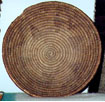
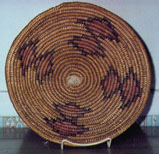
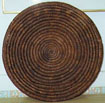 19th-century
possibly Pueblo baskets.
19th-century
possibly Pueblo baskets.Possibly Jicarilla Apache basket
Ts'aa' are used in a number of ceremonial ways: to hold ritual objects, such as prayersticks and medicine bundles; to hold yucca suds for ritual baths and hair washing; as drums when inverted and struck with a yucca drum stick; to hold food during the Navajo wedding ceremony, when cornmeal mush (taa'niil) is eaten, and to hold ground white clay (dleesh) , red ochre (chi'i'h), and cornmeal during the kinaalda', the coming of age ceremony for young women at puberty.
As Gladys Reichard*** writes in her study of Navajo religion
(published in 1950), a number of baskets may be necessary to a
ceremony: "A part of the agreement between
chanter and sponsor is the provision of the baskets, as important
as the payment to the singer. When the chant is over, some baskets
are presented to the chanter or some other participant in the
ceremony; borrowed baskets are returned to their owner, who may
be the chanter or almost anyone who can provide them. Certain
taboos, some very strict, attach to the basket. Nowadays it has
become an article of trade, procurable at a trading post. Baskets
so bought may be considered neutral, having no restrictions and
no evil attached to them; the ceremony gives them the blessing
value."
"Because of the 'drawing power' of the earth, sacred objects
should not touch the ground; consequently, ceremonial properties--...prayersticks,
hoops, [medicine] bundle equipment--must be placed on or in something;
it is often a basket, especially for assembled bundle equipment.
...
"The basket represents jewels and therefore the potentiality
of wealth, with its provision for proper offerings. Baskets are
often thought of as consisting of one of the precious stones,
rimmed with a contrasting jewel..." and thus different baskets
are used in different ceremonies.
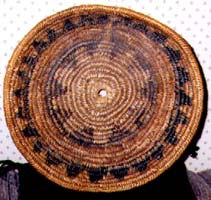
This is a very old Navajo basket. According to A. H. Whiteford, "The most distinctive feature of old baskets with traditional designs is their construction: coil foundations of two sumac rods topped with a hank or twist of yucca fibers" (p. 37). This ts'aa' has a twisted fiber start that continues for a number of coils, and then has two-rod construction with a fiber overlay. The large size of the opening start is also somewhat unusual. It feels like it has been in many ceremonies.
**Indian Baskets, by Sarah P. & William A. Turnbaugh (West Chester, PA: Schiffer Publishing Ptd., 1986, pps. 222-224).
***Gladys A. Reichard, Navaho Religion: A Study of Symbolism (Bollingen Series XVIII, Princeton University Press, 1950, 1977, p. 522-523).
See Andrew Hunter Whiteford, Southwestern Indian Baskets: Their History and Their Makers, Santa Fe, NM: School of American Research Press, 1988, chapter 3.)
"This night we will again do a holy thing... This will be made known to you: a name will be made for this woman, who has come into being, and singing will be done over her to provide her with the means of continuing to be holy in the future."
(--Frank Mitchell, telling of Changing Woman's puberty rite, from the Navajo Blessing Way, in: Blessingway, Leland C. Wyman, University of Arizona Press, 1970, p. 408.)

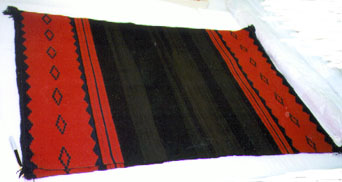
Kinaalda'--Coming of Age II
Outside the hooghan
I added my sleeping bag
to the pile of blankets.
The girl came out,
lay down on them,
and her aunt began to mold her
to grow straight and strong.
The sky behind the girl
was very blue
beyond the shade
of the woman's hands
shaping her.
Her unbound hair
and covered body
sheltered the blankets--
she stood up
beneath a song.
Our faces were brushed with pollen
like bees
swaying at flowers.
The girl folded each blanket
and gave them back
as prayer shawls,
one by one.
Wrapped in their blessings,
we were changed, and again changed--
we grew old, and young,
the women with babies,
and the women with grey hair.Someone with keen eyes
had seen the pattern.
Someone with dexterous fingers
had made knots, and the fringes
at four corners
that led to coverts,
safe in the dangerous world.
This is the way
I would have liked
to be blessed the first time--
beneath a canopy.
Biil woven by Joselene Towne, daughter of Evelyn Towne, of Rough Rock, Navajo Nation (Arizona), for her high school graduation, May 1997.
Woman's biil (two-piece dress) second panel, late 19th century. Texas Memorial Museum collection, Austin, Texas.
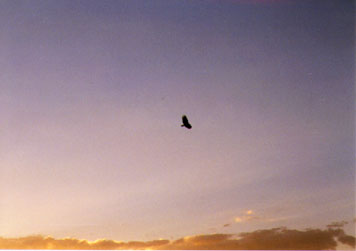
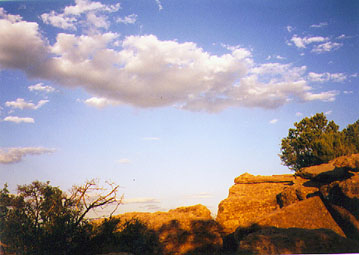
Poems fromWeaving the Light © 1997
Carol Snyder Halberstadt. All rights reserved.
Photographs © 1997 Carol Snyder Halberstadt. All rights reserved.
Return to Wings to Fly With
Publishing introduction.
Return to Migrations home page.
Go to Sea Mammals page.
Go to Listening to the
Stone page.